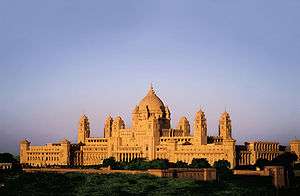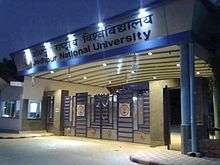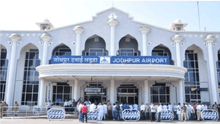Jodhpur
| Jodhpur जोधपुर | |
|---|---|
| Metropolis | |
|
Mehrangarh Fort, Jodhpur | |
 Jodhpur  Jodhpur | |
| Coordinates: 26°17′N 73°01′E / 26.28°N 73.02°ECoordinates: 26°17′N 73°01′E / 26.28°N 73.02°E | |
| Country |
|
| State | Rajasthan |
| District | Jodhpur[1] |
| Settled | 1459 |
| Founded by | Rao Jodha of Mandore |
| Named for | Rao Jodha |
| Government | |
| • Type | Mayor-council |
| • Body | JMC |
| • Mayor, Municipal Corporation | Ghanshyam Ojha |
| • Collector & DM | Sh. Bishnu Charan Mallick, IAS |
| • Police Commissioner of Jodhpur | Ashok Rathore, IPS |
| Area[2] | |
| • Metropolis | 289.6 km2 (111.8 sq mi) |
| • Metro | 624.5 km2 (241.1 sq mi) |
| Elevation | 231 m (758 ft) |
| Population (2016 Census)[3] | |
| • Metropolis | 1,637,815 |
| • Rank | 35th |
| • Density | 5,700/km2 (15,000/sq mi) |
| • Metro[4] | 1,720,000 [5] |
| Languages | |
| • Official | Marwari language, Hindi |
| Time zone | IST (UTC+5:30) |
| PIN | 342001 |
| Vehicle registration | RJ 19 |
| Website |
www |
Jodhpur (/ˈdʒɒdpʊər/ ![]() Listen ) is the second largest city in the Indian state of Rajasthan. It is the second metropolitan city of the state and the thirty-fifth largest city in India. It was formerly the seat of a princely state of the same name. The capital of the kingdom known as Marwar. Jodhpur is a popular tourist destination, featuring many palaces, forts and temples, set in the stark landscape of the Thar Desert.
Listen ) is the second largest city in the Indian state of Rajasthan. It is the second metropolitan city of the state and the thirty-fifth largest city in India. It was formerly the seat of a princely state of the same name. The capital of the kingdom known as Marwar. Jodhpur is a popular tourist destination, featuring many palaces, forts and temples, set in the stark landscape of the Thar Desert.
The city is known as the "Sun City" for the bright and sunny weather it enjoys all the year round. The old city circles the fort and is bounded by a wall with several gates.[6] Jodhpur is also known as "Blue City" because of the blue colours that decorate many of the houses in the old city area.[7] However, the city has expanded greatly outside the wall over the past several decades. Jodhpur lies near the geographic centre of Rajasthan state, which makes it a convenient base for travel in a region much frequented by tourists.
The Tamil movie, I, which is the costliest Indian film to date, was also shot in Jodhpur.[8]
History

According to the Rajasthan District Gazetteer's of Jodhpur and the Hindu epic Ramayana (composed up to the 4th century AD), Abhiras (Ahirs) were the original inhabitants of Jodhpur and later Aryans spread to this region.[9][10]
Jodhpur was also part of the Gurjara–Pratihara Empire and until 1100 AD was ruled by a powerful Gurjar King. Jodhpur was founded in 1459 by Rao Jodha, a Rajput chief of the Rathore clan. Jodha succeeded in conquering the surrounding territory and thus founded a state which came to be known as Marwar. As, Jodha hailed from the nearby town of Mandore, that town initially served as the capital of this state; however, Jodhpur soon took over that role, even during the lifetime of Jodha. The city was located on the strategic road linking Delhi to Gujarat. This enabled it to profit from a flourishing trade in opium, copper, silk, sandals, date palms and coffee.

In between 1540 and 1556, Afghans were in control of most of North India. Rajasthan born Hemu who started his career as a supplier of various types of merchandise to Sher Shah Suri empire, held various positions in capital Delhi as 'Incharge of Food Affairs', 'Minister of Internal Security', 'Prime Minister-cum-Chief of Army' with Islam Shah Suri and Adil Shah, who ruled north India from Punjab to Bengal at that point in time. Hemu, who took as the military commander of Afghan army in 1553, crushed the first rebellion, killing the Governor of Ajmer province Juneid Khan and appointed his own Governor in Rajasthan. Hem Chandra won several battles (22) throughout North India against Afghan rebels and twice against Akbar at Agra and Delhi, before his coronation at Purana Quila in Delhi on 7 October 1556 as a 'Vikramaditya' king. Hemu lost his life in the Second Battle of Panipat on 5 November 1556, and the area came under Mughal king Akbar.
Early in its history, the state became a fief under the Mughal Empire, owing fealty to them while enjoying some internal autonomy. During this period, the state furnished the Mughals with several notable generals such as Maharaja Jaswant Singh. Jodhpur and its people benefited from this exposure to the wider world: new styles of art and architecture made their appearance and opportunities opened up for local tradesmen to make their mark across northern India.

Aurangzeb briefly sequestrated the state (c.1679) on the pretext of a minority, but the rightful ruler Maharaja Ajit Singh was restored to the throne by Veer Durgadas Rathore after Aurangzeb died in 1707 and a great struggle of 30 years. The Mughal empire declined gradually after 1707, but the Jodhpur court was beset by intrigue; rather than benefiting from circumstances, Marwar descended into strife and invited the intervention of the Marathas, who soon supplanted the Mughals as overlords of the region. This did not make for stability or peace, however; 50 years of wars and treaties dissipated the wealth of the state, which sought and gratefully entered into subsidiary alliance with the British in 1818.
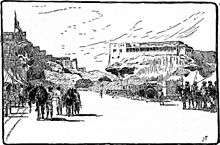
During the British Raj, the state of Jodhpur had the largest land area of any in Rajputana. Jodhpur prospered under the peace and stability that were a hallmark of this era. The land area of the state was 23,543 sq mi (60,980 km2) its population in 1901 was 44,73,759. It enjoyed an estimated revenue of £35,29,000/. Its merchants, the Marwaris, flourished without let or limit and came to occupy a position of dominance in trade across India. In 1947, when India became independent, the state merged into the union of India and Jodhpur became the second largest city of Rajasthan.
At the time of partition, ruler of Jodhpur Hanwant Singh did not want to join India, but finally due to the effective persuasion of Sardar Vallabhbhai Patel, the then Home Minister at the centre, the princely state of Jodhpur was included in Indian Republic. Later after State Reorganisation Act, 1956 it was made part of the state of Rajasthan.


Demographics
As per provisional reports of Census India,[4] population of Jodhpur is 1,033,918 in 2011; of which male and female nearly constitute 52.62 percent and 47.38 percent respectively. Average literacy rate of Jodhpur city is 81.56 percent of which male and female literacy was 88.42 and 73.93 percent respectively. Total children under 6 years of age constitute nearly 12.24 percent of city population. Jodhpur city is governed by Municipal Corporation which comes under Jodhpur Urban Agglomeration. The Jodhpur Urban/Metropolitan area include Jodhpur, Kuri Bhagtasani, Mandore Industrial Area, Nandri, Pal Village and Sangariya. Its Urban/Metropolitan population is 1,137,815 of which 599,332 are males and 538,483 are females.
| Population Growth of Jodhpur City | |||
|---|---|---|---|
| Census | Pop. | %± | |
| 1881 | 142,600 | — | |
| 1891 | 61,800 | -56.7% | |
| 1901 | 60,400 | -2.3% | |
| 1911 | 59,300 | -1.8% | |
| 1921 | 73,500 | 23.9% | |
| 1931 | 94,700 | 28.8% | |
| 1941 | 126,900 | 34.0% | |
| 1951 | 180,700 | 42.4% | |
| 1961 | 224,800 | 24.4% | |
| 1971 | 318,900 | 41.9% | |
| 1981 | 506,345 | 58.8% | |
| 1991 | 666,279 | 31.6% | |
| 2001 | 860,818 | 29.2% | |
| 2011 | 1,137,815 | 32.2% | |
| source:[11] | |||
Climate
The climate of Jodhpur is generally hot and semi-arid, but with a rainy season from late June to September (Köppen BShw). Although the average rainfall is around 450 millimetres (18 in), it is extraordinarily variable. In the famine year of 1899, Jodhpur received only 24 millimetres (0.94 in), but in the flood year 1917 it received as much as 1,178 millimetres (46.4 in).
Temperatures are extreme throughout the period from March to October, except when monsoonal rain produces thick clouds to lower it slightly. In the months of April, May and June, high temperatures routinely exceed 40 degrees Celsius. During the monsoon season, average temperatures decrease slightly. However, the city's generally low humidity rises and this adds to the normal discomfort from the heat. Phalodi, near Jodhpur, is the driest place of the district as well as in the state. The highest temperature recorded in Jodhpur is on 18 May 2016 when it rises up to 53.2 degrees Celsius.
| Climate data for Jodhpur | |||||||||||||
|---|---|---|---|---|---|---|---|---|---|---|---|---|---|
| Month | Jan | Feb | Mar | Apr | May | Jun | Jul | Aug | Sep | Oct | Nov | Dec | Year |
| Record high °C (°F) | 31.2 (88.2) |
36.0 (96.8) |
41.6 (106.9) |
45.0 (113) |
47.4 (117.3) |
47.8 (118) |
42.6 (108.7) |
40.3 (104.5) |
42.5 (108.5) |
40.6 (105.1) |
37.5 (99.5) |
32.3 (90.1) |
47.8 (118) |
| Average high °C (°F) | 24.5 (76.1) |
27.4 (81.3) |
33.4 (92.1) |
38.4 (101.1) |
41.4 (106.5) |
40.0 (104) |
35.2 (95.4) |
33.5 (92.3) |
34.9 (94.8) |
35.8 (96.4) |
31.2 (88.2) |
26.9 (80.4) |
33.55 (92.38) |
| Average low °C (°F) | 9.6 (49.3) |
11.7 (53.1) |
17.3 (63.1) |
22.6 (72.7) |
26.5 (79.7) |
27.8 (82) |
26.4 (79.5) |
25.4 (77.7) |
23.9 (75) |
20.1 (68.2) |
14.7 (58.5) |
11.2 (52.2) |
19.77 (67.58) |
| Record low °C (°F) | 1.8 (35.2) |
0.7 (33.3) |
4.4 (39.9) |
15.6 (60.1) |
15.4 (59.7) |
20.0 (68) |
21.0 (69.8) |
21.2 (70.2) |
18.4 (65.1) |
12.5 (54.5) |
5.8 (42.4) |
1.7 (35.1) |
0.7 (33.3) |
| Average precipitation mm (inches) | 4.0 (0.157) |
4.0 (0.157) |
1.3 (0.051) |
4.8 (0.189) |
17.4 (0.685) |
40.0 (1.575) |
120.5 (4.744) |
111.5 (4.39) |
49.9 (1.965) |
6.9 (0.272) |
1.9 (0.075) |
0.5 (0.02) |
362.7 (14.28) |
| Source: IMD (extreme high and lows up to 2010 for Jodhpur (RS/RW))[12][13] | |||||||||||||
Economy

The Handicrafts industry has in recent years eclipsed all the other industries in the city. Other items manufactured include textiles, metal utensils, bicycles, ink and sporting goods. A flourishing cottage industry exists for the manufacture of such items as glass bangles, cutlery, carpets and marble products.
After handicrafts, tourism is the second largest industry of Jodhpur. Crops grown in the district include wheat and the famous Mathania red chillies. Gypsum and salt are mined. The city serves as an important marketplace for wool and agricultural products. The Indian Air Force, Indian Army, Indo Tibetan Border Police and Border Security Force maintain training centres in Jodhpur.
The administration of Jodhpur consists of a District Collector, followed by 4 Additional District Magistrates (I, II, Land Conversion and City ADM). Presently, the Collector and District Magistrate is Dr. Preetam B. Yashwant (IAS). The city is also under Police Commissioner system, with Mr. Ashok Rathore (IPS) as Police Commissioner of the city.
The upcoming 9 MMTPA Refinery and Petrochemical complex to be set up by Hindustan Petroleum Corporation Limited (HPCL) in Pachpadra, Barmer will transform the industrial scene of the city drastically. Pachpadra lies just 60 kilometres from the industrial area of Boranada in Jodhpur. Around 120 by-products that are produced by the refinery are going to provide opportunities for new industries to be set up in and around Jodhpur.
India's most ambitious industrial development project, the over USD 100 billion dollars Delhi-Mumbai Industrial Corridor Project is also going to impact industries in Jodhpur. Marwar Junction, which is located about 103 kilometres from Jodhpur will be one of the nine freight loading points along the DMIC route. Jodhpur and Pali districts fall under the region that is going to be developed as a manufacturing hub for the DMIC.
Elected representatives
The present Member of Parliament from Jodhpur is Gajendra Singh Shekhawat of BJP.

The current MLAs from the 3 constituencies of Jodhpur are from Jodhpur City: Shri Kailash Bhansali, Chartered Accountant; from Sardarpura: Shri Ashok Gehlot, Ex-Chief Minister of Rajasthan; from Soorsagar: Smt. Suryakanta Vyas.Other MLAs from different constituencies ae as follows: Luni- Sh. Joga Ram Patel,Shergarh- Sh. Babu Singh Rathore, Bilara- Smt. Kamsa meghwal and Bopalgarh- Sh Arjun lal garg. Meghraj Lohiya, senior BJP Leader has been re-appointed as Chairman (State Minister) of Rajasthan Small Industries Corporation Ltd.

Strategic location
Jodhpur is the most important city of western Rajasthan and lies about 250 kilometres from the border with Pakistan. This location makes it an important base for the Indian army, Indian Air Force and Border Security Force (BSF). Jodhpur's air base is Asia's largest and one of the most critical and strategically located airbases of the IAF (Jodhpur Airport played the crucial role during Indo-Pakistan wars in 1965 and 1971) deployed with fighter jets Sukhoi Su-30MKI and Advanced Light Helicopters Dhruv.
Culture
The city is famous for its food and its popularity can be judged from the fact that one can find sweet shops named 'Jodhpur Sweets' in many cities throughout India. Being at the onshore of Thar desert, life has been influenced with ways of the desert folks (gypsies can be found in many parts of the city).
Tourism
Jodhpur's attractions include Mehrangarh Fort, Umaid Bhawan Palace, Jaswant Thada, Ghanta Ghar (Popularly known as the Clock Tower) and Flying Fox [Mehrangarh Fort]. Tourists can make excursions to Mandore, Kaylana Lake and Garden, Balsamand Lake, Mandaleshwar Mahadev Temple (Mandalnath), Ratanada Ganesh Temple, Sardar Samand Lake and Palace, Masooria Hills, Veer Durgadas Smarak (monument, park and museum), Bhim Bhirak Cave, Ravan Ka Mandir (the only Ravan's temple in India).
The beautiful historic buildings and scenic landscapes of the city were featured in some major films, including (The Dark Knight Rises directed by Christopher Nolan, The Darjeeling Limited starring Owen Wilson, Adrien Brody, and Jason Schwartzman, and The Fall directed by Tarsem Singh), Hum Saath-Saath Hain, Veer, and Shuddh Desi Romance.
Places of recreation

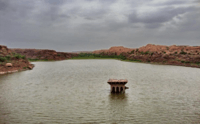
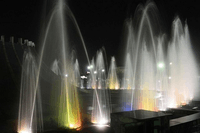
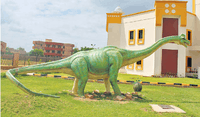
Some of the recreation places worth mentioning are:
- Mandore Gardens
- Kaylana Lake
- Shastri Circle
- Masuria Hill Garden
- Rao Jodha Desert Rock Park
- Science Park
- Ummed Garden
- Chokelav Baag
- Machiya Safari Park
Fairs and festivals
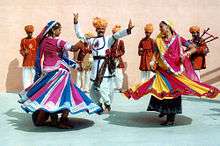
- Marwar Festival
- Gangaur
- Baithmaar Gangaur Mela
- Teej
- Nag Panchami Fair
- Sheetla Mata Fair
- Baba Ramdev Pir Mela
- Rajasthan International Folk Festival (RIFF)
Temples
- Chamunda Mata Temple (near Mehrangarh Fort)
- Raj Ranchhodji Temple
- Achal Nath Shivalaya
- Siddhanth Shiv Temple
- Rasik Bihari Temple
- Ganesh Temple
- Baba Ramdeo Temple, Masuria hill
- Shiv Temple, Shiv Sagar, Mata ka than
- Udai Mandir in city area
- Kunj Bihari Temple
- Dauji Temple, Hathi Ram ka Oda
- Ravan Temple
Cuisine

A number of Indian delicacies have originated in Jodhpur. To name a few, the Makhaniya Lassi, Mawa Ki Kachori, Pyaaj Ki Kachori, Hot & Spicy Mirchi Bada (A preparation made with potato, onion, chilli and gramflour), Dal Bati Churma (dal is lentils; bati is baked wheat ball; and churma is powdered sweetened cereal), Lasan Ki Chutney (hot fiery garlic chutney), Mirchi Ka Kutaa (hot recipe of crushed green chilies), Gatte Ki Sabzi (A delicacy made up of gramflour balls, curd and spices), Ker Sangri Sabzi (also known as Pachkutaa - the five ingredients of Pachkutaa are sangri, ker, kumatiya, dried goonda and dried red chillies), Raab (pearl millet flour and yoghurt curry), Lapsi (a special kind of dessert made with cracked wheat, Jaggery, coconut and ghee), Aate Ka Halwa (wheat flour dessert), Kachara Mircha Sabzi (made with chilli and Kachara, a special type of vegetable grown in desert area) and Kadhi Pakoda (recipe made with gramflour, curd and chilli) with Baajre Ka Sogra (a thick flat and round bread of pearl millet). Jodhpur is known for its sweets ranging from traditional "Makhanbada", "Mawa Ki Kachori", "Malpua", "Ghevar", "Motichur Ke Laddu", "Besan barfi", "Thorr" and "Gulab Jamun" to Bengali "Rasgulla" and "Ras Malai" prepared by a traditional house "Jodhpur Sweets".
Sports
Jodhpur has two outdoor stadiums and one indoor stadium complex. Barkatullah Khan Stadium has hosted two cricket ODIs (one-day internationals).
| S No | Team (A) | Team (B) | Winner | Margin | Year |
|---|---|---|---|---|---|
| 1 | | | | By 1 wicket | 2000 |
| 2 | | | | By 3 wickets | 2002 |
Education and research



Jodhpur is fast becoming a major education hub for higher studies in India. Almost every major discipline has a dedicated institution in the city. With many renowned academicians, Jodhpur is India's largest hub for preparation of the Chartered Accountant (CA) entrance examination held throughout India by the Institute of Chartered Accountants of India (ICAI).
Major institutions are:
- Indian Institute of Technology Jodhpur (IITJ) is a technical education institute in India, one of the new IITs. (It started in 2008.)
- All India Institute of Medical Sciences Jodhpur (AIIMS Jodhpur)
- National Law University Jodhpur (NLU Jodhpur) is one of the 17 universities imparting law education (established in 1999).
- National Institute of Fashion Technology Jodhpur (NIFT Jodhpur): a fashion design institute (started in 2010).
- Dr. Sarvepalli Radhakrishnan Rajasthan Ayurved University (DSRRAU Jodhpur) is a university in the field of Ayurveda. A second university of its kind in India was started in 2003.
- Jai Narain Vyas University (JNVU, Jodhpur), formerly known as University of Jodhpur, is run by the State Government of Rajasthan (established in 1962).
- Dr. S.N. Medical College, Jodhpur (established in 1965)
- MBM Engineering College: the oldest engineering institution in Rajasthan, now a faculty of Engineering and Architecture, under JNVU, (established in 1951)
- Footwear Design and Development Institute Jodhpur (FDDI Jodhpur) is an institute established by the Government of India, Ministry of Commerce & Industry for the design and development of footwear, fashion and leather (started in 2012).
- Indian Institute of Handloom Technology (IIHT Jodhpur) is one of the five institutes nationwide to provide research, development and technical education to the handloom industry.
- Sardar Patel University of Police Security and Criminal Justice, started in 2013, is a university for research and education in the field of security, policing and criminal justice.
Some other institutions of significance are:
- Government Polytechnic College
- Government College of Physical Education
- Government College, Chenpura
- Lachoo Memorial College of Science & Technology (LMCST)
- Onkarmal Somani College of Commerce
- Mahila P.G Mahavidyalaya
- Prof. A.D Bohra Memorial Law College
- Jodhpur National University
- JIET (Jodhpur) (Jodhpur Institute of Engineering & Technology)
- Marwar Engineering College & Research Centre
- S.L.B.S Engineering College
- Mayurakshi Institute of Engineering & Technology
- Raj Engineering College
- Vyas Institute of Higher Education
- Aishwarya college of education
Research
Major research institutes and organisations have been established in the city for promoting research:
- Arid Forest Research Institute is one of the institutes of the Indian Council of Forestry Research and Education (ICFRE) working under the Ministry of Environment & Forests, Govt. of India for carrying out scientific research in forestry to provide technologies to increase the vegetative cover and to conserve the biodiversity in the hot arid and semi-arid region of Rajasthan, Gujarat and Dadara union Nagar Haveli union territory. The campus covers 66 hectares of area on the New Pali Road.
- Central Arid Zone Research Institute (CAZRI) is a premier Organisation of the Indian Council of Agricultural Research (ICAR), an autonomous organisation under the Department of Agricultural Research and Education, Ministry of Agriculture, Government of India.
- Desert Medicine Research Centre (DMRC) is one of the 33 permanent institutes of Indian Council of Medical Research which is an autonomous body for the formulation, co-ordination and promotion of bio-medical research in the country.
- Desert Regional Centre, Zoological Survey of India (DRC-ZSI) is the regional arm of the only taxonomic organisation in the country involved in the study of all kinds of animals to promote survey, exploration and research leading to the advancement in the knowledge of aspects of the exceptionally rich animal life.
- Botanical Survey of India (BSI) is the nodal research organisation under Ministry of Environment and Forests for research, exploration and survey of the plant life of India.
- Defence Research and Development Organisation (DRDO) is an organisation working under the Department of Defence Research and Development of Ministry of Defence for design and development leading to production of world-class weapon systems and equipment.
- Regional Remote Sensing Centre (RRSC, ISRO) is one of the five centres established under National Natural Resources Management System (NNRMS) by Department of Space for remote sensing tasks at regional and national levels.
- MBM Engineering College: Research in Master and Ph.D. programmes in branches of engineering is done by highly experienced faculty. In civil and chemical engineering, national and state projects are performed by this college.
Judiciary

Rajasthan High Court is the High Court of the state of Rajasthan. It was established on 21 June 1949 under the Rajasthan High Court Ordinance, 1949.
The seat of the court is at Jodhpur. The court has a sanctioned judge strength of 40. View of the Rajasthan High Court, Sardar museum in Umaid Park and upper right is Jodhpur fort in 1960.
The High Court of Rajasthan was founded in 1949 at Jodhpur, and was inaugurated by the Rajpramukh, Maharaja Sawai Man Singh on 29 August 1949. The first Chief Justice was Kamala Kant Verma and the current Chief Justice of the Rajasthan High Court is Hon'ble Mr. Justice Satish Kumar Mittal. A bench was formed at Jaipur which was dissolved in 1958 and was again formed on 31 January 1977. Currently the sanctioned strength of the judges is 40.
Civic administration
| Jodhpur City officials | |
|---|---|
| Mayor | Mr. Ghanshyam Ojha |
| Collector | Sh. Vishnu Charan Mallik,[14] IAS |
| Police Commissioner | Mr. Ashok Rathore |
| Chief Justice of the Rajasthan High Court | Hon'ble Mr. Justice Satish Mittal |
| Chairman, Jodhpur Development Authority | |
The city is administered by the Jodhpur Nagar Nigam headed by a mayor. For administrative purposes, the city is divided into 65 wards, from which the members of the corporation council are elected for five years. Municipal corporation has 65 elected members known as councillors (ward members; parshad in Hindi) representing their respective wards (65 geographical units of the city). The ward members are elected by direct voting by ward-wise electorate for a period of 5 years. In addition to these 65 directly elected members the corporation has 4 Ex-officio members (1 member of parliament, 3 members of legislative assembly namely Sardarpura, Soorsagar, City) and 3 Nominated Members.
Transportation
The city has well established rail, road and air networks connecting it to other major cities of the country.
Railways

Jodhpur railway station is the divisional headquarters of the North Western Railways (NWR). It is well connected with railways to major Indian cities like Alwar, Delhi, Mumbai, Kolkata, Chennai, Bangalore, Trivandrum, Pune, Kota, Kanpur, Bareilly, Hyderabad, Ahmedabad, Indore, Bhopal, Dhanbad, Patna, Guwahati, Nagpur, Lucknow, Gwalior, Jaipur etc. To decongest the main Jodhpur station (JU), the suburban station Bhagat ki Kothi (BGKT) is being developed as the second main station for passenger trains. At present 106 trains serves to both the stations. Some of the important trains originating from Jodhpur railway station are- Ranthambore Express (Jodhpur to Indore), Mandore Express (Jodhpur to Delhi), Suryanagri Express (Jodhpur to Mumbai), Marudhar Express (Jodhpur to Lucknow), Howrah Superfast (From Jodhpur to Howrah) etc.
For further train running information, timings, halts etc. visit the official website of Indian Railways
Luxury train service- For experiencing the true magnificence and royal opulence of Rajasthan, luxury trains Palace on Wheels and Royal Rajasthan on Wheels are run jointly by RTDC and Indian railways. Jodhpur is one of the destinations of both of the trains. Recently a plan to start metro train service in Jodhpur was proposed to decongest the city traffic.however the proposal is still pending with state government for its approval.
Suburban stations around Jodhpur
| No. | Suburban Station Name[15] | Distance (in km) |
|---|---|---|
| 1 | Raikabagh Palace Junction | 02 |
| 2 | Bhagat Ki Kothi railway station | 03 |
| 3 | Mahamandir Railway Station | 05 |
| 4 | Basani Railway Station | 06 |
| 5 | Jodhpur Cantt Railway Station | 08 |
| 6 | Mandor Railway Station | 10 |
| 7 | Banar Railway Station | 14 |
| 8 | Salawas Railway Station | 16 |
Air
Jodhpur Airport is one of the prominent airports of Rajasthan. It is primarily a military airbase with civil enclosure to allow for civilian air traffic. Due to Jodhpur's strategic location, this airport is regarded as one of the most important ones for the Indian Air Force.
At present, there are daily flights from Delhi, Mumbai, Udaipur ,Jaipur and Bangalore to the city operated by Air India and Jet Airways and Spicejet. The bill and basic formalities for the long-awaited expansion of the airport were cleared by all the concerned authorities in June 2016, clearing the way for the expansion of the airport in two phases beginning Feb 2016. Post the expansion, it is expected that there will be morning and evening flights from the city to more cities than presently available in addition to more airlines coming to and fro the city.
Road
Jodhpur is connected by road to all major cities in Rajasthan and neighbouring states like Delhi, Ahmedabad, Surat, Ujjain, Agra etc. Apart from deluxe and express bus services to cities within the state, Rajasthan Roadways provides Volvo & Mercedes Benz bus service to Delhi, Ahmedabad, Jaipur, Udaipur and Jaisalmer (click here for time table and reservations). Recently, Bus Rapid Transit System (BRTS) is launched in the city with low floor and semi low floor buses plying on major routes. Jodhpur is connected to the National Highway network with three National Highways and to the Rajasthan State Highway network with ten state highways. National Highways passing through Jodhpur:
- NH-62, Ambala-Kaithal-Hissar-Fatehpur-Jodhpur-Pali, total length= 690 km
- NH-112, Junction with NH-14 near Bar connecting Jaitaran-Bilara-Kaparda-Jodhpur-KalyanpurPachpadra-Baloootra-Tilwara-Kher-BagundiDhudhwa-madhasar-Kawas and terminating at its junction with NH 15 near Barmer, total length= 343 km
- NH-114, Junction with NH-65 near Jodhpur connecting Balesar - Dechhu and terminating at its junction with NH-15 near Pokaran, total length= 180 km
State Highways passing thorugh Jodhpur:
- SH-19, Phalodi (NH 15) to Needar via Ahu, Chadi, Pachudi, Nagaur, Tarneu, Khatu Kalan, Khatu khurd, Toshina, Kuchaman City, Bhuni, Maroth, Deoli Minda, Renwal Crossing, Kaladera, total length= 368 km
- SH-21, Dantiweara to Merta City via Pipar City, Borunda, total length= 97 km
- SH-28, Phalodi (NH 15) to Ramji ki Gol via Deeechu, Shergarh, Pachpadra, Balotra, Sindri, Guda Malani.total length= 259 km
- SH-58, Jodhpur to Bheem up to NH 8 via Vinakiya, Rajola Sojat, Rendiri, Bhaisana, Sojat Road, Kantalia, Baban. total length= 142 km
- SH-61, Phalodi ( NH 15) to Mandal via Osian, Mathania, Jodhpur, Khejrali, Bhatenda, Saradasamand, Jadan, Marwar Junction, Auwa, Jojawar, Kamalighat, Devgarh, Rajaji ka kareda.total length=349 km
- SH-62, Bilara to Pindwara via Sojat, Sireeyari, Jojawar, Bagol, Desuri, Sadri, Sewari.total length=187 km
- SH-63, Banar to Kuchera via Bhopalgarh Asop.total length=129 km
- SH-65, Sheo (NH 15) to Shergarh via Bhiyad, Barnawa Jagger, Patodi, Phalsoond.total length=155 km
- SH-66, Siwana to Dhandhaniya (NH 114) via Samdari, Kalyanpur, Mandli Rodhawa Kalan.total length=90 km
- SH-68, Dangiyawas (NH 112) to Balotra via Kakelao, Khejarli, Guda Kakani, Luni, Dhundhara, Rampura, Samdari.total length=131 km
FM stations
Jodhpur has total of five FM stations:
- Big FM
- Red FM
- My FM
- Nav Vividh Bharti
- Radio Mirchi FM
See also
- Arid Forest Research Institute (AFRI) Jodhpur
- Mandore
- Rajputs
References
- ↑ "Jodhpur.nic.in".
- ↑ "Jodhpur District Census 2011 Handbook: VILLAGE AND TOWN WISE PRIMARY CENSUS ABSTRACT (PCA)" (PDF). Censusofindia.gov.in. p. 33. Retrieved 19 April 2016.
- ↑ ORGI. "Census of India : Provisional Population Totals Paper 1 of 2011 : Rajasthan".
- 1 2 3 "Jodhpur City Population Census 2011 - Rajasthan".
- ↑ "Major Agglomerations of the World - Population Statistics and Maps".
- ↑ Gopal, Madan (1990). K.S. Gautam, ed. India through the ages. Publication Division, Ministry of Information and Broadcasting, Government of India. p. 178.
- ↑ Forster, Stuart. "Why is Jodhpur Known as the Blue City?".
- ↑ "Vikram's 'Ai' attracts from Hollywood - bollywood.bhaskar.com". www.bhaskar.com. Retrieved 28 July 2015.
- ↑ Rajasthan [district Gazetteers].: Jodhpur-page-18
- ↑ Rajasthan [district Gazetteers].: Jodhpur – Rajasthan (India). Government Central Press. 1979.
- ↑ "Historical Census of India".
- ↑ "Jodhpur Climatological Table Period: 1971–2000". India Meteorological Department. Retrieved 1 July 2016.
- ↑ "Ever recorded Maximum and minimum temperatures up to 2010" (PDF). India Meteorological Department. Retrieved April 15, 2015.
- ↑ http://jodhpur.nic.in/tel-state.html
- ↑ "Suburban Railway Stations of Jodhpur".
Further reading
- Jodhpur, Published by [s.l.], 1933.
- Maharaja of Marwar 1973.
- Marwar under Jaswant Singh, (1658–1678): Jodhpur hukumat ri bahi, by Satish Chandra, Raghubir Sinh, Ghanshyam Dattan Singh of Jodhpur and His Times (1803–1843 A.D.), by padmaja Sharma. Published by Shiva Lal Agarwala, 1972.
- The Administration of Jodhpur State, 1800–1947 A.D., by Nirmala M. Upadhyaya. International Publishers, Sharma. Published by Meenakshi Prakashan, 1976.
- The History of Rajputana-Vol.IV, PartII. The History of the Jodhpur State, Part II, Veer Durgadas. 1941, Dr. Gaurishankar Hirachand Ojha.
- Jodhpur, Bikaner, Jaisalmer: Desert Kingdoms, by Kishore Singh, Karoki Lewis. Lustre Press Ltd. 1992.
- The House of Marwar: The Story of Jodhpur, by Dhananajaya Singh. Lotus Collection, Roli Books, 1994. ISBN 81-7436-002-6.
- Modern Indian Kingship: Tradition, Legitimacy & Power in Jodhpur, by Marzia Balzani. Published by James Currey Limited, 2003. ISBN 0-85255-931-3.
- Rathod Durgadas by Pt. Bishweshharnath Reu, 1948, Archaeological Department, Jodhpur.
- Veer Durgadas Rathor by Dr. L. S. Rathore, Thar Bliss Publisher, Jodhpur, 1987.
- Jodhpur and the Later Mughals, AD 1707–1752, by R. S. Sangwan. Published by Pragati Publications, 2006.
External links
| Wikimedia Commons has media related to Jodhpur. |
| Wikivoyage has a travel guide for Jodhpur. |
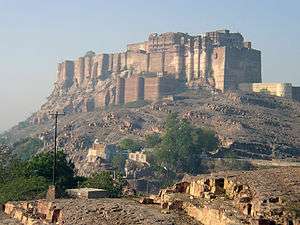 |
|
|
 |
| Jodhpur | Rajasthan | India | Udaipur |
.jpg)

